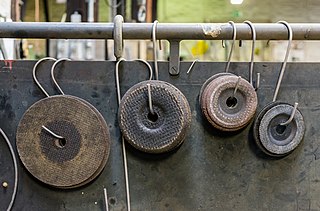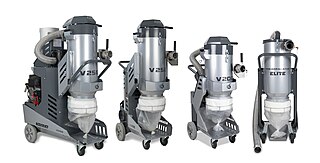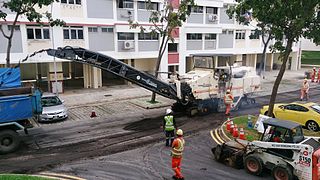Related Research Articles

A road surface (English), or pavement (American), is the durable surface material laid down on an area intended to sustain vehicular or foot traffic, such as a road or walkway. In the past, gravel road surfaces, macadam, hoggin, cobblestone and granite setts were extensively used, but these have mostly been replaced by asphalt or concrete laid on a compacted base course. Asphalt mixtures have been used in pavement construction since the beginning of the 20th century and are of two types: metalled (hard-surfaced) and unmetalled roads. Metalled roadways are made to sustain vehicular load and so are usually made on frequently used roads. Unmetalled roads, also known as gravel roads, are rough and can sustain less weight. Road surfaces are frequently marked to guide traffic.
An abrasive is a material, often a mineral, that is used to shape or finish a workpiece through rubbing which leads to part of the workpiece being worn away by friction. While finishing a material often means polishing it to gain a smooth, reflective surface, the process can also involve roughening as in satin, matte or beaded finishes. In short, the ceramics which are used to cut, grind and polish other softer materials are known as abrasives.

Asphalt concrete is a composite material commonly used to surface roads, parking lots, airports, and the core of embankment dams. Asphalt mixtures have been used in pavement construction since the beginning of the twentieth century. It consists of mineral aggregate bound together with bitumen, laid in layers, and compacted. The process was refined and enhanced by Belgian-American inventor Edward De Smedt.

A grinding machine, often shortened to grinder, is a power tool used for grinding. It is a type of machining using an abrasive wheel as the cutting tool. Each grain of abrasive on the wheel's surface cuts a small chip from the workpiece via shear deformation.

Grinding wheels are wheels that contain abrasive compounds for grinding and abrasive machining operations. Such wheels are also used in grinding machines.
A grinding dresser or wheel dresser is a tool to dress the surface of a grinding wheel. Grinding dressers are used to return a wheel to its original round shape, to expose fresh grains for renewed cutting action, or to make a different profile on the wheel's edge. Utilizing pre-determined dressing parameters will allow the wheel to be conditioned for optimum grinding performance while truing and restoring the form simultaneously.

A dowel bar retrofit (DBR) is a method of reinforcing cracks in highway pavement by inserting steel dowel bars in slots cut across the cracks. It is a technique which several U.S. states' departments of transportation have successfully used in repairs to address faulting in older jointed plain concrete pavements. The typical approach is to saw cut and jackhammer out the slots for the dowels. Following dowel placement the slots are then typically backfilled with a non-shrink concrete mixture, and the pavement is diamond-ground to restore smoothness.
Optical manufacturing and testing spans an enormous range of manufacturing procedures and optical test configurations.

A diamond tool is a cutting tool with diamond grains fixed on the functional parts of the tool via a bonding material or another method. As diamond is a superhard material, diamond tools have many advantages as compared with tools made with common abrasives such as corundum and silicon carbide.

Road slipperiness is a condition of low skid resistance due to insufficient road friction. It is a result of snow, ice, water, loose material and the texture of the road surface on the traction produced by the wheels of a vehicle.

Drainage gradient (DG) is a term in road design, defined as the combined slope due to road surface cross slope (CS) and longitudinal slope (hilliness). Although the term may not be used, the concept is also used in roof design and landscape architecture.

Grinding is a type of abrasive machining process which uses a grinding wheel as cutting tool.

A concrete grinder can come in many configurations, the most common being a hand-held angle grinder, but it may be a specialized tool for countertops or worktops. Angle grinders are small and mobile, and allow one to work on harder to reach areas and perform more precise work.
Surface grinding is done on flat surfaces to produce a smooth finish.

Polished concrete is a multi-step process where a concrete floor is mechanically ground, honed and polished with bonded abrasives in order to cut a concrete floor's surface. It is then refined with each cut in order to achieve a specified level of appearance.

The Nooitgedacht Glacial Pavements comprise a geological feature between Kimberley and Barkly West, South Africa, pertaining to the Palaeozoic-age Dwyka Ice Age, or Karoo Ice Age, where the glacially scoured ancient bedrock was used, substantially more recently, during the Later Stone Age period in the late Holocene as panels for rock engravings.

The International Grooving & Grinding Association (IGGA) is a non-profit trade association founded in 1972 that represents the industry that performs grooving and grinding of both concrete and asphalt surfaces in addition to Concrete Pavement Restoration (CPR) and Concrete Pavement Preservation (CPP) methods. CPR and CPP methods are a series of engineered techniques developed during the last 40 years to manage the rate of pavement deterioration in concrete streets, highways and airports. A non-overlay option used to repair areas of distress in concrete pavement without changing its grade, CPR restores the pavement to a condition close to or better than original and reduces the need for major and more costly repairs later. CPP/CPR addresses the cause of pavement distress, minimizing further deterioration. Covering road distress with an asphalt overlay does not correct the cause and will eventually manifest itself again, usually as a larger, more expensive problem. Asphalt overlays typically last eight to 12 years, whereas CPP and CPR last up to 30 years.
Concrete pavement restoration (CPR) together with concrete pavement preservation (CPP) is a group of various techniques used to maintain concrete roadways.
Diamond grinding is a pavement preservation technique that corrects a variety of surface imperfections on both concrete and asphalt concrete pavements. Most often utilized on concrete pavement, diamond grinding is typically performed in conjunction with other concrete pavement preservation (CPP) techniques such as road slab stabilization, full- and partial-depth repair, dowel bar retrofit, cross stitching longitudinal cracks or joints and joint and crack resealing. Diamond grinding restores rideability by removing surface irregularities caused during construction or through repeated traffic loading over time. The immediate effect of diamond grinding is a significant improvement in the smoothness of a pavement. Another important effect of diamond grinding is the considerable increase in surface macrotexture and consequent improvement in skid resistance, noise reduction and safety.

Pavement milling is the process of removing at least part of the surface of a paved area such as a road, bridge, or parking lot. Milling removes anywhere from just enough thickness to level and smooth the surface to a full depth removal. There are a number of different reasons for milling a paved area instead of simply repaving over the existing surface.
References
- ↑ Wenzel, Thomas H.; Kuemmel, David A.; Drakopoulos, Alexander; Abadi, Fariborz Vazir (1999). The Effects of Grinding on PCC Pavements . Retrieved 10 May 2023.